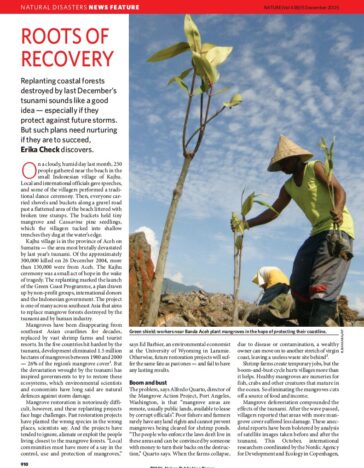
Roots of Recovery in Nature
-
Coastal resilience
-
Coastal wetland conservation
Replanting coastal forests destroyed by last December’s tsunami sounds like a good idea – especially if they protect against future storms. But such plans need nurturing if they are to succeed, Erika Check discovers.
The Green Coast project is one of many across southeast Asia that aims to replace mangrove forests destroyed by the tsunami and by human industry. Mangrove restoration is notoriously difficult: past projects have planted the wrong species in the wrong places or did not involve the people living close to the mangroves.
Wetlands International Indonesia Programme (WIIP) has a long-term experience of mangrove restoration in Asia. WIIP negotiates agreements with villagers to plant and care for the seedlings. The programme supports staff and a loan to start businesses. If 70% of the seedlings are still alive after five years, the village keeps the money; otherwise they repay part of the loan.
”It”s been a really big challenge, and I don”t want to say our appoach will be succesful,” says Nyoman Suryadiputra, technical director of WIIP. “We want to do this properly from the beginning, and that”s not easy.” Yet those with experience say approaches that involve local people are the only ones that make sense.
Many southeast Asian governments now have pledged their support for mangrove restoration. International donor groups also offered money and seedlings. Now the question is whether (government) commitments to restoration will last longer than one year after the tsunami.

